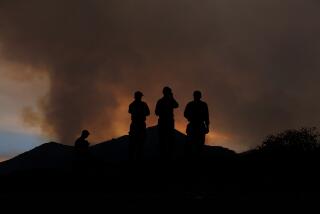Colorado evacuees wait as wildfires blaze on
- Share via
MASONVILLE, Colo. — Linda Panepinto walked into the tiny post office and tried to muster cheerfulness. Just over the ridge, the High Park fire raged, its thick smoke stinging her eyes and scratching her throat. Monday launched week three of her evacuation limbo — bunking in safety with family, not sure whether she will have a home when it’s all over.
“Maybe today,” she said brightly to postmaster Juillene Hewitt as she picked up her mail. Rumors travel swiftly these days, and the latest was that some canyon residents may get to return to their homes soon. Panepinto apologized about the unpaid post office box bill, but her checkbook was back at her log house. Her husband had been able to gather only a handful of family photos and her father’s artwork before he fled with their four cats.
“Maybe today,” Hewitt echoed, waving off concerns about the bill. “There’s more important things to worry about.”
Colorado is on fire. The state is roiling under the devilish orange-glow threat of at least six massive blazes that have forced thousands to evacuate. Fire officials said there was little chance of containment of the state’s largest and most destructive High Park fire any time soon. It could be fall until all the fires are extinguished.
Panepinto and her neighbors vacillate between dread and hope. They climb surrounding hilltops with binoculars and telescopes to see whether their homes have survived. Panepinto was helping move cattle to safety a few days ago and saw that her little house was still standing. But the High Park fire “is a monster,” she said.
The toll is reported daily by the numbers: The High Park fire has devoured 83,205 acres and 248 homes, making it the second largest in Colorado history and the most destructive when measured by the loss of homes. More than 2,000 firefighters are doing battle, but the fire is only 45% contained. Firefighting costs have reached nearly $30 million.
Low winter snowfall brought on an early fire season, said Tom Tidwell, chief of the U.S. Forest Service. Years of drought, record-breaking heat and low humidity, coupled with miles of dead, dry trees killed from beetle infestations, have converged to make for the incendiary conditions.
On a fire danger index of 1 to 6, based on temperature and moisture content of vegetation, Colorado has measured a “super 6” since Saturday, said Steve Segin, public information officer for the Rocky Mountain Area Coordination Center, which coordinates firefighting in five states.
Also of concern is the Waldo Canyon fire, just west of Colorado Springs with its population of almost half a million. The fire, ignited Saturday and 0% contained, has burned nearly 3,500 acres and displaced 6,000 residents. But it has not destroyed any homes. Tourist attractions such as the towering red rock formations of Garden of the Gods park and the Pikes Peak highway remain closed.
A fire that ignited quickly Saturday and destroyed 21 homes and cabins in Estes Park, a tourist town not far from the High Park fire, is now contained.
Panepinto said the mammoth blazes had taken a toll on the independent spirit she and her mountain neighbors have long relished.
“We are used to being self-reliant,” she said. “Your whole life is now on edge because you feel like you can’t control anything.”
Since the fire began, she says, her stomach will not unclench and sleep will not come. “I don’t think I will be able to really sleep until the first snowfall.”
More to Read
Sign up for Essential California
The most important California stories and recommendations in your inbox every morning.
You may occasionally receive promotional content from the Los Angeles Times.












